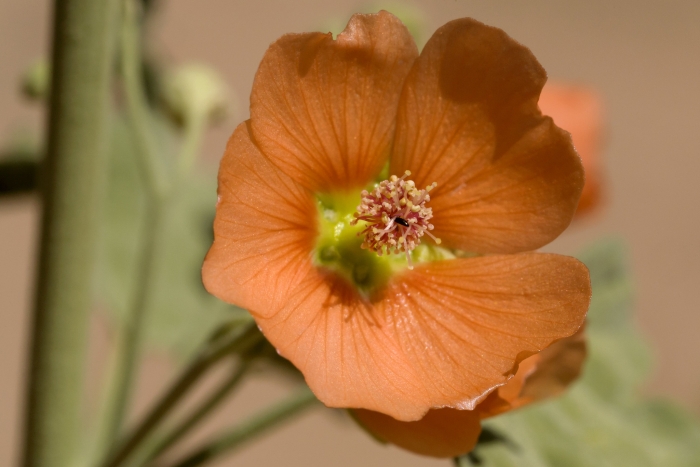Emory’s Globemallow
(Sphaeralcea emoryi)
Emory’s Globemallow (Sphaeralcea emoryi)
/
/

Patrick Alexander
CC0
Image By:
Patrick Alexander
Recorded By:
Copyright:
CC0
Copyright Notice:
Photo by: Patrick Alexander | License Type: CC0 | License URL: http://creativecommons.org/publicdomain/zero/1.0/deed.en | Uploader: Josve05a | Publisher: Wikimedia Commons |



















Estimated Native Range
Summary
Sphaeralcea emoryi, commonly known as Emory’s Globemallow, is an evergreen perennial subshrub or herb native to desert scrub, arid grasslands, and open areas in the Southwestern United States and Northern Mexico. It can reach heights exceeding two meters, with a similar spread, and is characterized by its woolly erect stems. The gray-green leaves are oval to triangular, often lobed, and up to 5.5 centimeters long. From late spring to early fall, it produces a showy inflorescence with clusters of bright orange or sometimes lavender flowers, each with five petals about a centimeter long, attracting pollinators.
Emory’s Globemallow is valued for its drought tolerance and vibrant flowers, making it an excellent choice for xeriscaping and naturalistic plantings in arid regions. It is often used in restoration projects, as it establishes easily on disturbed sites. This plant thrives in full sun and requires minimal water once established, preferring well-drained soils. While it is generally low-maintenance, it can be susceptible to root rot if overwatered. Emory’s Globemallow can also be used for erosion control due to its extensive root system.CC BY-SA 4.0
Emory’s Globemallow is valued for its drought tolerance and vibrant flowers, making it an excellent choice for xeriscaping and naturalistic plantings in arid regions. It is often used in restoration projects, as it establishes easily on disturbed sites. This plant thrives in full sun and requires minimal water once established, preferring well-drained soils. While it is generally low-maintenance, it can be susceptible to root rot if overwatered. Emory’s Globemallow can also be used for erosion control due to its extensive root system.CC BY-SA 4.0
Plant Description
- Plant Type: Subshrub, Herb
- Height: 1.7-3 feet
- Width: 1.7-3 feet
- Growth Rate: Moderate
- Flower Color: Orange
- Flowering Season: Winter, Spring, Summer
- Leaf Retention: Evergreen
Growth Requirements
- Sun: Full Sun
- Water: Low
- Drainage: Fast
Common Uses
Bee Garden, Bird Garden, Deer Resistant, Drought Tolerant, Hummingbird Garden, Low Maintenance, Potted Plant, Rabbit Resistant, Street Planting
Natural Habitat
Native to desert scrub, arid grasslands, and open areas in the Southwestern United States and Northern Mexico
Other Names
Common Names:
Scientific Names: , Sphaeralcea emoryi, Sphaeralcea emoryi var. variabilis, Sphaeralcea emoryi var. emoryi, Sphaeralcea emoryi var. arida, Sphaeralcea emoryi subsp. variabilis, Sphaeralcea emoryi subsp. emoryi, Sphaeralcea arida, Sphaeralcea emoryi var. californica, Sphaeralcea fendleri var. californica
GBIF Accepted Name: Sphaeralcea emoryi Torr. ex A.Gray